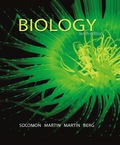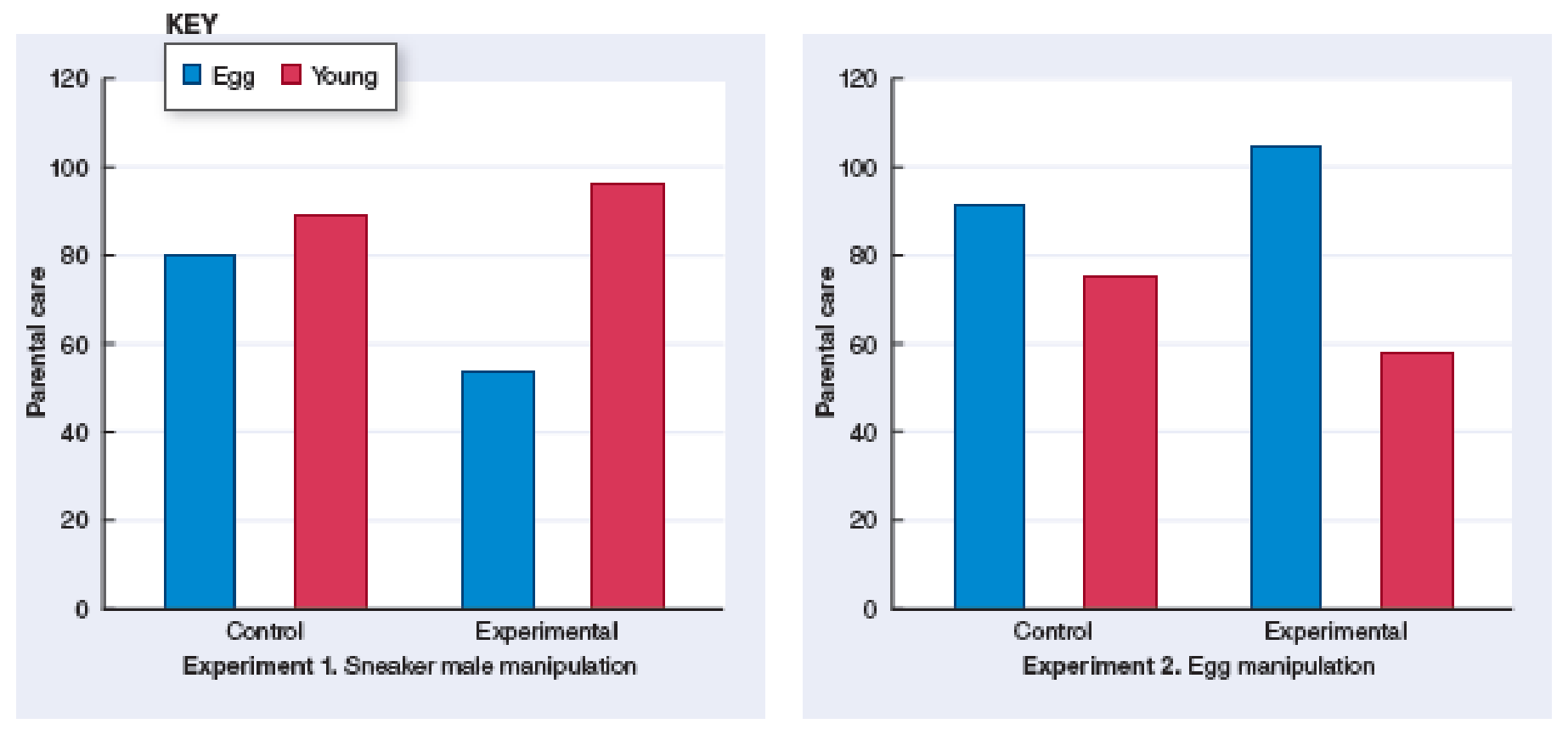
Concept explainers
INTERPRET DATA Look at the two graphs in Figure 52-21. In which experiment did the parentals in the experimental group guard the eggs more closely? In which experiment did the experimental parentals guard the young more closely? Account for these differences.

RESULTS:
Experiment 1: As indicated on the y-axis, which measures level of parental care, parentals reduced their level of guarding the eggs. Eight of the males in the experimental group abandoned their nests, and egg defense was significantly lower in this group compared with that in the control group. However, after eggs hatched, there was little difference in parental care of the young between the two groups.
Experiment 2: During the egg phase, there was little difference in level of parental care between experimental and control groups. However, after eggs hatched, the experimental parentals significantly decreased their level of guarding the nest.
CONCLUSION: Male bluegill sunfish adjust their level of parental care according to their level of perceived paternity.
In Experiment 1, parentals provided less care when they perceived that the eggs may have been fertilized by sneaker males. After the eggs hatched, olfactory cues indicated that the offspring were indeed their own, and their level of care increased.
In Experiment 2, parentals cared for the eggs even though some had been swapped. However, after they hatched, olfactory cues from the offspring indicated that they were not the parental’s own offspring. The level of parental care decreased significantly.
SOURCE: B.D. Neff, Nature, Vol. 422 (April 17, 2003): 716–719.
Figure 52-21 Decisions about parental care
Want to see the full answer?
Check out a sample textbook solution
Chapter 52 Solutions
EBK BIOLOGY
- Selection of Traits What adaptations do scavengers have for locating and feeding on prey? What adaptations do predators have for capturing and consuming prey?arrow_forwardCompetition Between Species What natural processes limit populations from growing too large? What are some resources organisms can compete over in their natural habitat?arrow_forwardSpecies Interactions Explain how predators, prey and scavengers interact. Explain whether predators and scavengers are necessary or beneficial for an ecosystem.arrow_forward
- magine that you are conducting research on fruit type and seed dispersal. You submitted a paper to a peer-reviewed journal that addresses the factors that impact fruit type and seed dispersal mechanisms in plants of Central America. The editor of the journal communicates that your paper may be published if you make ‘minor revisions’ to the document. Describe two characteristics that you would expect in seeds that are dispersed by the wind. Contrast this with what you would expect for seeds that are gathered, buried or eaten by animals, and explain why they are different. (Editor’s note: Providing this information in your discussion will help readers to consider the significance of the research).arrow_forwardWhat is the difference between Uniporters, Symporters and Antiporters? Which of these are examples of active transport?arrow_forwardWhat are coupled transporters?arrow_forward
- How do histamine and prostaglandins help in the mobilization of leukocytes to an injury site? What are chemotactic factors? How do they affect inflammation process?arrow_forwardCompare and contrast neutrophils and macrophages. Describe two ways they are different and two ways they are similar.arrow_forwardDescribe the effects of three cytokines (not involved in the initial inflammation response). What cells release them?arrow_forward
 Biology (MindTap Course List)BiologyISBN:9781337392938Author:Eldra Solomon, Charles Martin, Diana W. Martin, Linda R. BergPublisher:Cengage Learning
Biology (MindTap Course List)BiologyISBN:9781337392938Author:Eldra Solomon, Charles Martin, Diana W. Martin, Linda R. BergPublisher:Cengage Learning Biology Today and Tomorrow without Physiology (Mi...BiologyISBN:9781305117396Author:Cecie Starr, Christine Evers, Lisa StarrPublisher:Cengage Learning
Biology Today and Tomorrow without Physiology (Mi...BiologyISBN:9781305117396Author:Cecie Starr, Christine Evers, Lisa StarrPublisher:Cengage Learning Human Heredity: Principles and Issues (MindTap Co...BiologyISBN:9781305251052Author:Michael CummingsPublisher:Cengage Learning
Human Heredity: Principles and Issues (MindTap Co...BiologyISBN:9781305251052Author:Michael CummingsPublisher:Cengage Learning


